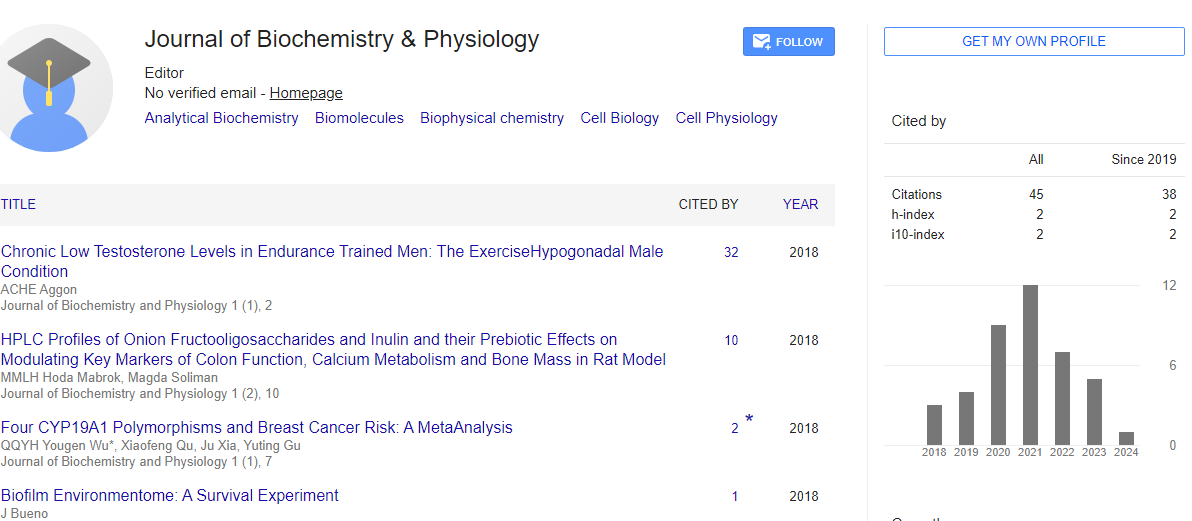Opinion Article, J Biochem Physiol Vol: 7 Issue: 1
Microbial Metabolism of Environmental Pollutants: Biodegradation Pathways and Applications
Lio Xe*
1Department of Nutrition, School of Public Health, Sun Yat-sen University, Guangzhou, PR China
*Corresponding Author: Lio Xe,
Department of Nutrition, School of Public Health,
Sun Yat-sen University, Guangzhou, PR China
E-mail: xelio@e.cn
Received date: 19 February, 2024, Manuscript No. JBPY-24-134954;
Editor assigned date: 21 February, 2024, PreQC No. JBPY-24-134954 (PQ);
Reviewed date: 11 March, 2024, QC No. JBPY-24-134954
Revised date: 20 March, 2024, Manuscript No. JBPY-24-134954 (R);
Published date: 29 March, 2024, DOI:10.4172/jbpy.1000152.
Citation: Xe L (2024) Microbial Metabolism of Environmental Pollutants: Biodegradation Pathways and Applications. J Biochem Physiol 7:1.
Description
Environmental pollution poses significant threats to ecosystems and human health, highlighting the urgent need for sustainable remediation strategies. Microbial biodegradation, facilitated by diverse microbial communities, offers a promising approach for the removal and detoxification of environmental pollutants. This article explores the microbial metabolism of environmental pollutants, focusing on biodegradation pathways and their applications in pollution remediation and bioremediation technologies.
Microorganisms exhibit remarkable metabolic versatility and adaptation capabilities, enabling them to degrade a wide range of organic pollutants, including hydrocarbons, pesticides, industrial chemicals, and pharmaceuticals. Bacteria, fungi, and archaea play key roles in pollutant biodegradation, utilizing diverse enzymatic pathways to break down complex organic molecules into simpler, non-toxic compounds. Microbial communities in contaminated environments often harbor specialized degraders capable of metabolizing specific pollutants, highlighting the importance of biodiversity in biodegradation processes.
Hydrocarbons are major components of petroleum-based fuels and industrial chemicals, posing significant environmental risks due to their toxicity and persistence in soil and water. Microbial hydrocarbon-degrading consortia, composed of aerobic and anaerobic bacteria, utilize various metabolic pathways to degrade hydrocarbons into carbon dioxide and water. Aerobic hydrocarbon-degrading bacteria, such as Pseudomonas, Acinetobacter, and Alcanivorax, utilize oxygenase enzymes to oxidize hydrocarbons, while anaerobic bacteria, such as Desulfobacter and Geobacter, utilize alternative electron acceptors, such as sulfate and iron, for hydrocarbon metabolism.
Pesticides are widely used in agriculture to control pests and increase crop yields, but their indiscriminate use can lead to environmental contamination and adverse effects on non-target organisms. Microbial degradation is an important pathway for pesticide removal and detoxification in soil and water environments. Bacterial and fungal species, such as Pseudomonas, Bacillus, and Trichoderma, produce a diverse array of enzymes, including hydrolases, oxidases, and dehalogenases, involved in pesticide degradation pathways. Bioremediation strategies leveraging pesticide-degrading microbes offer environmentally friendly alternatives to chemical treatment methods.
Industrial chemicals, including solvents, surfactants, and chlorinated compounds, are widespread pollutants that pose significant risks to environmental and human health. Microbial biodegradation pathways for industrial chemicals often involve enzymatic reactions, such as hydrolysis, oxidation, and reduction, mediated by specialized microbial consortia. For example, chlorinated solvents, such as Trichloroethylene (TCE) and Perchloroethylene (PCE), are degraded by aerobic and anaerobic bacteria through reductive dechlorination pathways, yielding non-toxic end products.
Pharmaceuticals and Personal Care Products (PPCPs) are emerging contaminants of concern due to their widespread use and persistence in the environment. Microbial biodegradation of PPCPs occurs through enzymatic transformations, such as hydroxylation, dealkylation, and conjugation, catalyzed by microbial enzymes. Bacterial species, such as Acinetobacter and Pseudomonas, are known to metabolize a wide range of pharmaceutical compounds, including antibiotics, analgesics, and hormones, in aquatic and terrestrial environments.
Microbial biodegradation technologies offer sustainable and costeffective solutions for environmental pollution remediation and waste management. Bioremediation strategies, such as bioaugmentation and biostimulation, harness the metabolic capabilities of indigenous or engineered microbial consortia to degrade pollutants in contaminated sites. In situ bioremediation techniques, such as bioventing, biosparging, and phytoremediation, enhance microbial activity and pollutant degradation in soil and groundwater environments. Microbial biodegradation also holds promise for the development of biobased processes for pollutant removal from industrial effluents and wastewater treatment.
Despite the promise of microbial biodegradation for environmental remediation, several challenges remain, including the identification and isolation of pollutant-degrading microbes, understanding the mechanisms of pollutant toxicity and persistence, and optimizing biodegradation processes under field conditions.
Conclusion
Microbial biodegradation is a powerful natural process for the removal and detoxification of environmental pollutants, offering sustainable solutions for pollution remediation and waste management. Understanding the metabolic pathways and ecological interactions of pollutant-degrading microbes is essential for developing effective bioremediation strategies and mitigating the environmental impact of human activities. Continued research and innovation in microbial biodegradation hold promise for addressing current environmental challenges and promoting sustainable development.
 Spanish
Spanish  Chinese
Chinese  Russian
Russian  German
German  French
French  Japanese
Japanese  Portuguese
Portuguese  Hindi
Hindi 